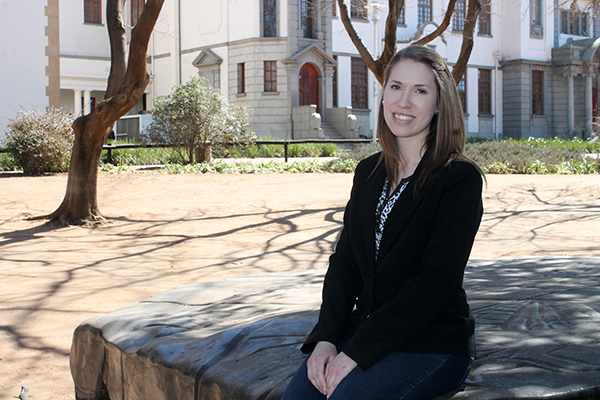Latest News Archive
Please select Category, Year, and then Month to display items
01 October 2019
|
Story Xolisa Mnukwa
|
Photo Xolisa Mnukwa
 From the left; Gift Taku, 2019 Doty winner; Reabetswe Mabine, Doty Coordinator Tshepo Zweni, first runner-up and Jacobeth Selinga, second runner-up
From the left; Gift Taku, 2019 Doty winner; Reabetswe Mabine, Doty Coordinator Tshepo Zweni, first runner-up and Jacobeth Selinga, second runner-up
The votes have been tallied, and after much deliberation, the UFS is proud to announce Gift Taku as the winner of the 2019 KovsieGear Designer of the Year (DOTY) Competition!
Tshepo Zwane and Jacobeth Selinga won second and third place respectively, with innovative designs that complied with the assessment requirements, based on originality of the design, adherence to the brand guidelines, creativity, and other criteria.
Gift’s design triumphed with 845 votes on the UFS KovsieLife webpage, as well as in the presentation in front of a judging panel.
Since 2016, KovsieGear has been discovering local (UFS staff and students) graphic designers and giving them a platform to showcase their work through DOTY, which runs annually. The aim of the competition is to support local talent by giving entrants an opportunity to come up with creative designs that are unique to the university and which will be used on limited-edition apparel in the store, as well as getting featured in the KovsieGear catalogue.
The competition has since fashioned the best clothing-logo designs the university has ever seen and continues to motivate and empower students to make positive contributions to the Kovsie campus culture and brand.
For more information about DOTY contact Reabetswe Mabine at MabineR@ufs.ac.za
The winning design by Gift Taku:

Humour a powerful tool to address serious issues
2017-12-06

Michelle Malan received a Dean’s medal from the Faculty of Humanities at the mid-year
graduation ceremonies for her Master’s degree.
Photo: Jóhann Thormählen
People, in most contexts, are more open to engage in serious issues such as politics and economics if it is presented in a humorous way. This makes humour a very powerful tool to address burning issues in our society.
These are some of the findings in the research of Michelle Malan, a part time lecturer in the Department of Linguistics and Language Practice at the University of the Free State (UFS).
How comedians and cartoonists use humour
The basic premise of her research, titled The Intersemiotic Translation of Humour, was to see how comedians and cartoonists take news stories and translate it into humour. She received the Dean’s medal for the best Master’s degree in the Faculty of the Humanities at the mid-year graduation ceremonies in June 2017.
“More specifically, I explored how the medium constrains potential meaning-making in cases of intersemiotic translation in which humour is constructed,” she says.
Cartoon vs a comic television show
According to her the medium in which a message is given, in this case comedy, definitely influences how one is able to form meaning from it. “For instance, a cartoon (visual medium) would have a different meaning-making potential than a comic television show.”
She also notes that one must understand the workings of humour, which includes the mediums in which it is presented, so that the intended humour does not do more harm than good.